Earth-Touch.com online HD wildlife channel
I remember when the internet was booming in the mid 90s and everyone was hyping up online content, all of my friends would say my videos allowed them to travel to the various locations and get the best out of the place in lieu of their travelling there and suffering through developing nation airports and all the other stuff. Even Bob Halstead joked about it in his Coral Sea Guide, whereby you’d send someone to an exotic, hard to reach location so they’d shoot whatever that is there for your viewing. Fast forward to 2007, with broadband internet available globally and connectivity reach scales only dreamed of in the early 90s, it became a reality and Earth-Touch is right on the forefront.
Earth-Touch.com is a online HD content company which aims to bring the wilderness frontier right to your monitor. They shoot and process on location, in some of the most remote and special places on Earth and within a few days (often within 24 hours), the public will see it online or on TV (with co-productions like WildTouch on SABC2 in South Africa). The Earth-Touch motto is “Real Life. Now!” all in HD too.
Started in 2007 in South Africa by Richard Van Wyk and Brian Palmer, Earth Touch has grown quickly, hiring several crews of camera men all over the world to shoot wildlife. Being based in South Africa, it was obligatory that Earth-Touch covered the great migration of sardine (Sardinops sagax) along the eastern coast of South Africa. Having 2 different crew they covered the phenomenon for over 1 month, giving daily updates online and occasionally on Wild-Touch.
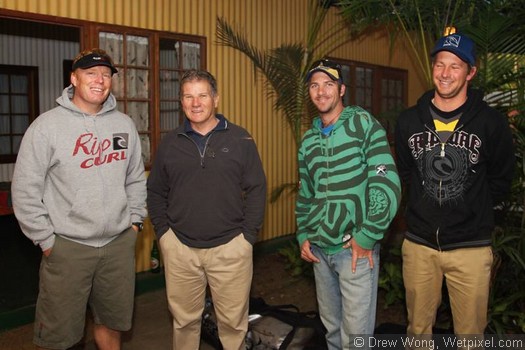
The Earth Touch crew with John Costello (Left: Barry, John, Grant, Ian)
It just so happens that the crew was staying where the Wetpixel crew were based, so we had a chance to watch their daily production routine. It didn’t hurt that their cameraman was Barry Skinstad, who happened to be a friend of mine. Barry is a very experienced freediver and started with Earth-Touch near the inception. He previously worked with Peter Lamberti, whose production of the Greatest Shoal on Earth about the sardine phenomena is shown on Discovery Channel.
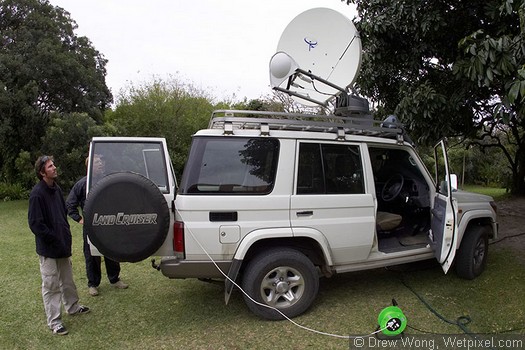
Grant and Barry watch as the dish aligns itself
Originally I’d wanted to interview Barry and his crew, Grant and Ian, for Wetpixel but since they were working hard every day (Grant and Ian were especially working hard at Jungle Monkey at night) I decided to just observe their operations. Even though the BBC crew were there, there was no mistaking the Earth-Touch caravan and their very big satellite dish on top of their vehicle. This was their secret weapon in the digital age. With this satellite dish, they could transmit their dailies back to the HQ for editing and posting online or broadcast the next day from anywhere in Southern Africa.
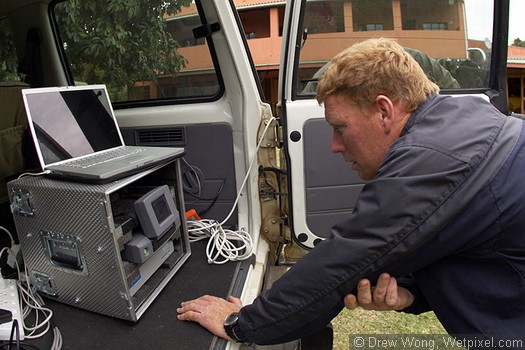
Barry readies the computer to upload the files to Earth Touch HQ
The Earth-Touch workflow is simple and efficient. They go on location and shoot in HD format, transmit the rushes to the HQ and repeat until the HQ says the story is done. I was fortunate enough to hang out with the crew and with their permission, I documented their daily process. First of all, their cameras were all HD cameras. The underwater rig was the venerable HVX200 in a Gates housing with a SWP44b wide angle lens with a 8GB cards and 16 GB card. They shoot DVCPRO HD 1080/50i, giving them about 30 minutes of recording time. The topside camera is a Sony HVR-Z7P, which they only shoot tape and not to CF cards, using the standard 20x lens. They shoot 1080/50i. They have an Apple MacBookPro as the main edit and a MacBook secondary computer. They use a FW400 spare drive as a backup. They also have a Hughes satellite dish on a Toyota Landcruiser, which they use to travel around in.
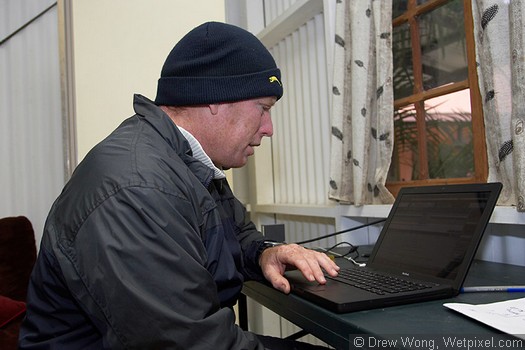
Barry reading Wetpixel while the satellite uploads
The crew’s daily routine goes something like this:
At 0530hrs, they prep to launch their boat by 0600hrs, just about an hour before sunrise. Once out at sea, they shoot both topside and underwater for any action that is found. Having seen them work hard to get the shots (and done the exact same thing myself daily), I can say it’s very hard work but that’s only half the day for Barry, Grant and Ian. There’s more than just image acquisition for them
Once they return to shore, they begin the download of clips from both cameras and organize the dailies with Final Cut Pro. The final rushes are chosen and then converted to a smaller file for transmission. One crew member does this while the other has to go prep the satellite dish to find and align with the right satellite in orbit. On top of the rushes, Barry also has to narrate a voiceover for the clips. Once all done and ready for transmission, they send the files at 60kbps to the Earth-Touch HQ. Often due to the large size of the files, it is done overnight.
Then it starts all over again the next day.
All that hard work in just one day culminates to this little piece that is shown the next day online: Earth Touch coverage.
Besides providing content for the online portion of the website, Earth-Touch also has to come up with complete program segments for the TV show, Wild-Touch. This includes interviews with scientists like Sean O’Donohue, mad scientist, who has been studying the sardine phenomena for his doctorate thesis.
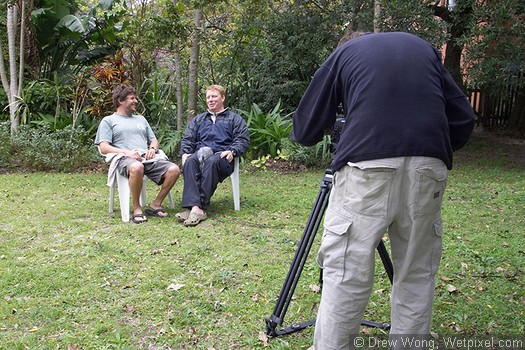
Barry interviews Sean with Grant as camera man
Barry and the other Earth-Touch crews are spread out in four continents to bring their viewers special wildlife content. They not only cover daily action but also do expeditions to far off places for content. As of now, Earth-Touch.com is in a beta state. Once fully online, Earth-Touch.com will become a paid subscription provider and also programming provider for TV around the world. While I do question how the market can sustain itself with so much piracy and difficulties with making deadlines, I do admire the company for providing content at such rapid speed. It’s almost like demand TV or more precisely… it’s “Real Life…NOW!”
-Drew Wong